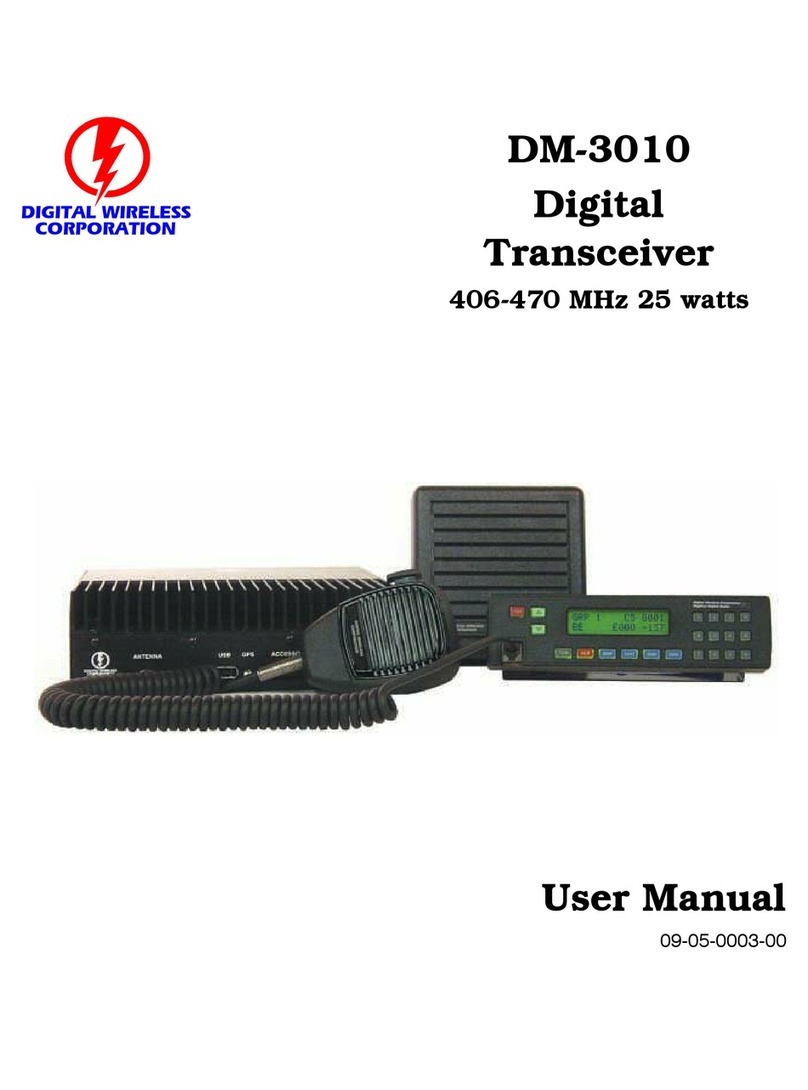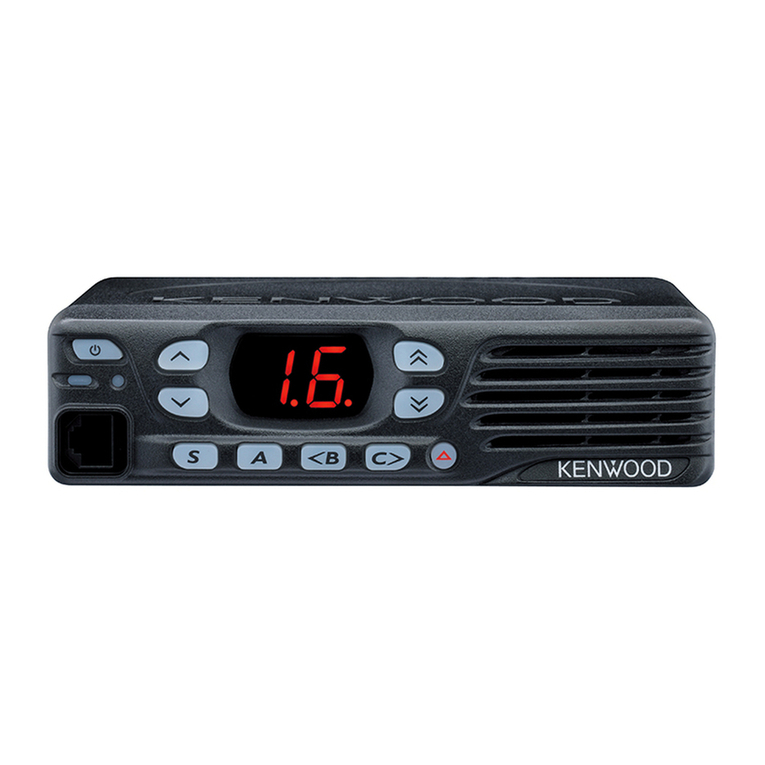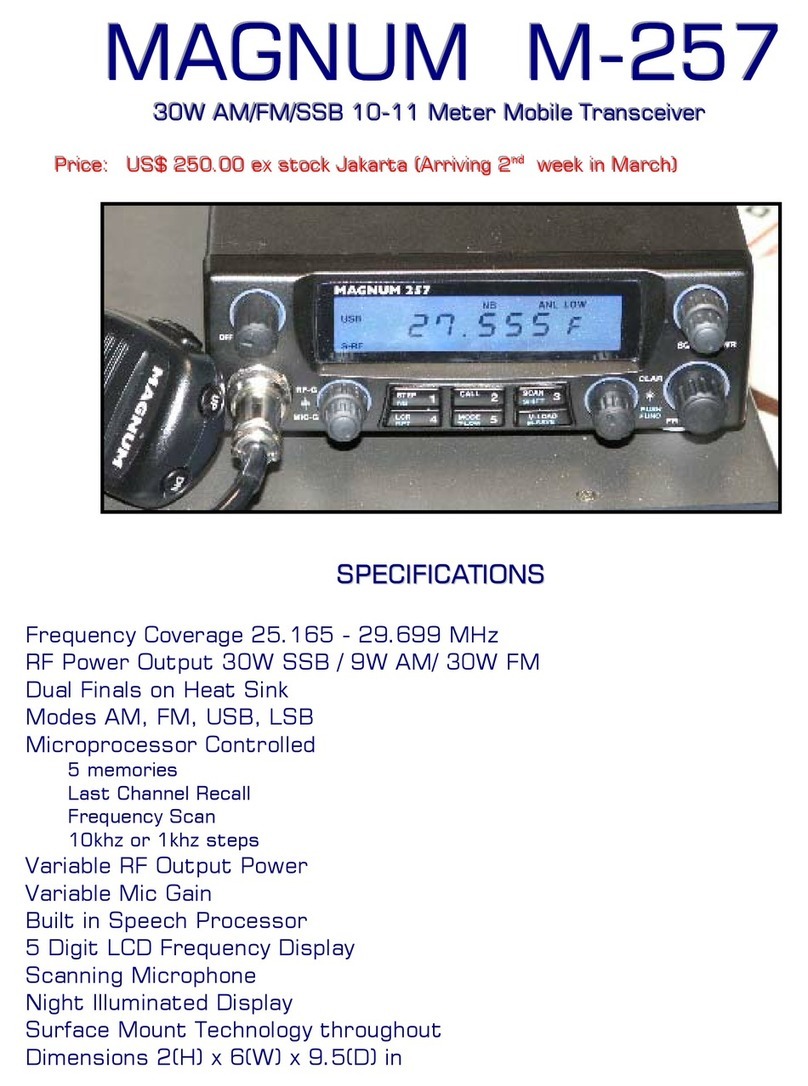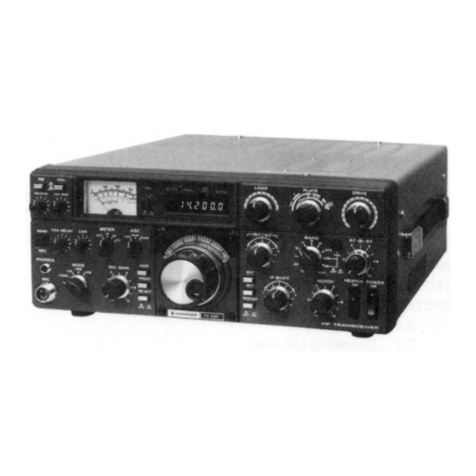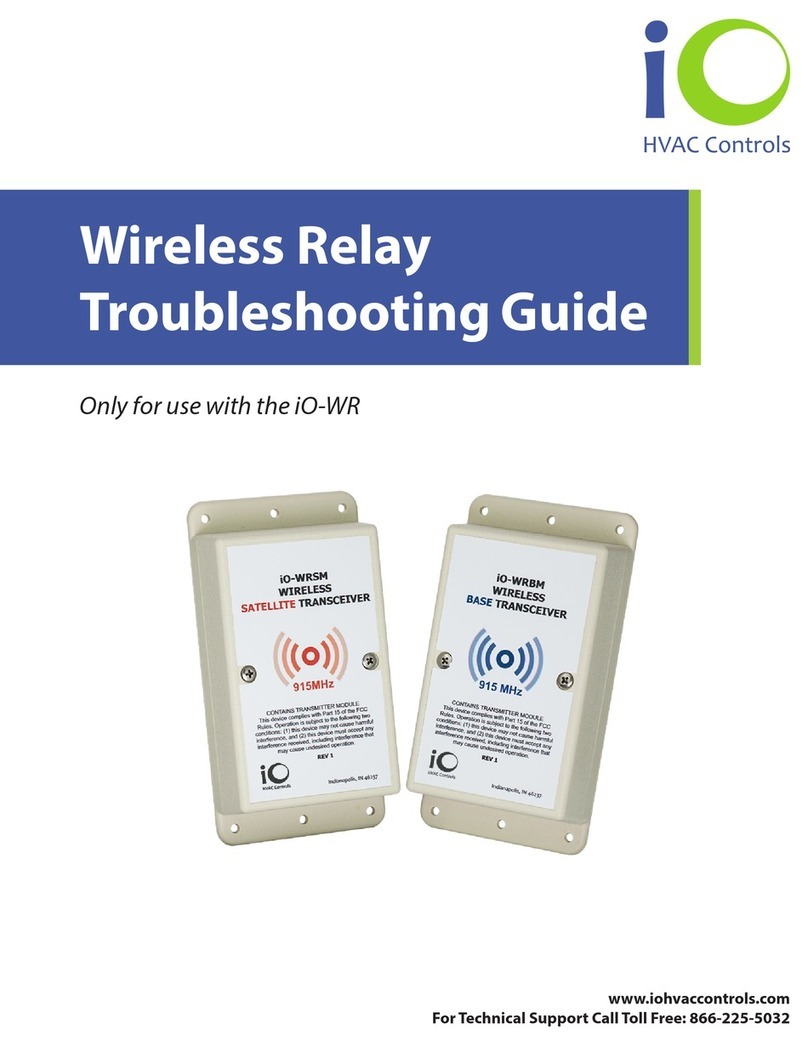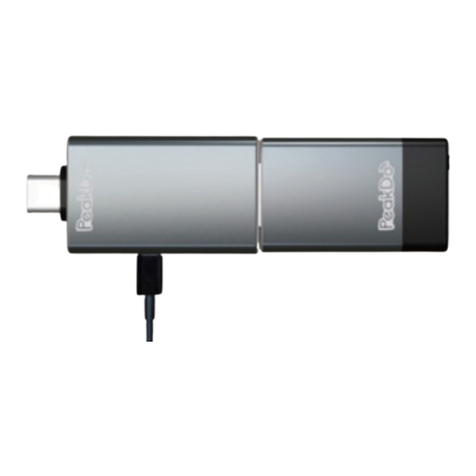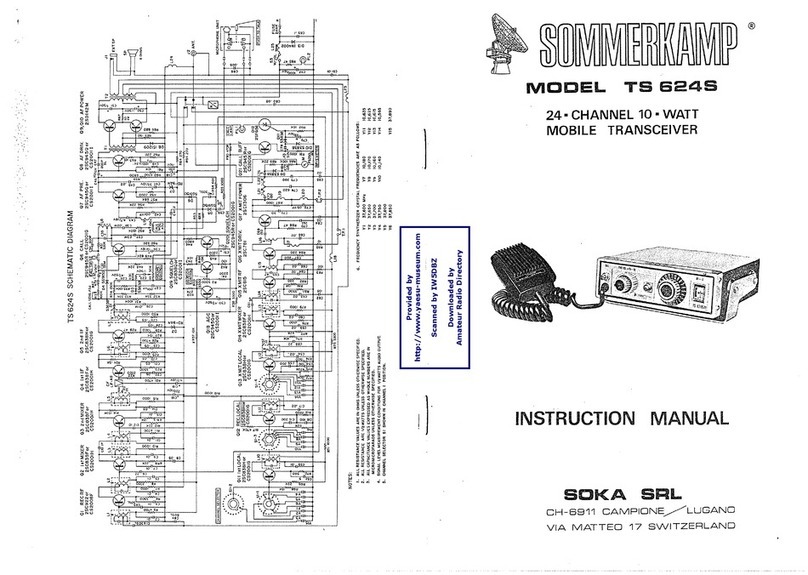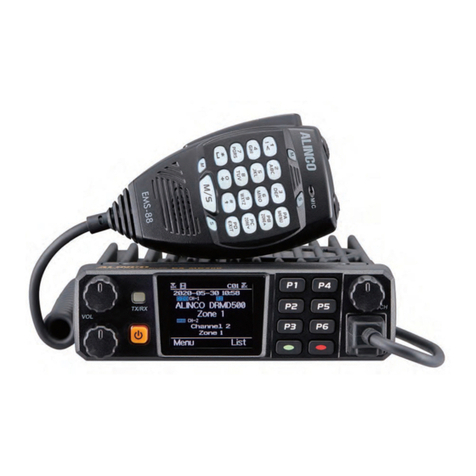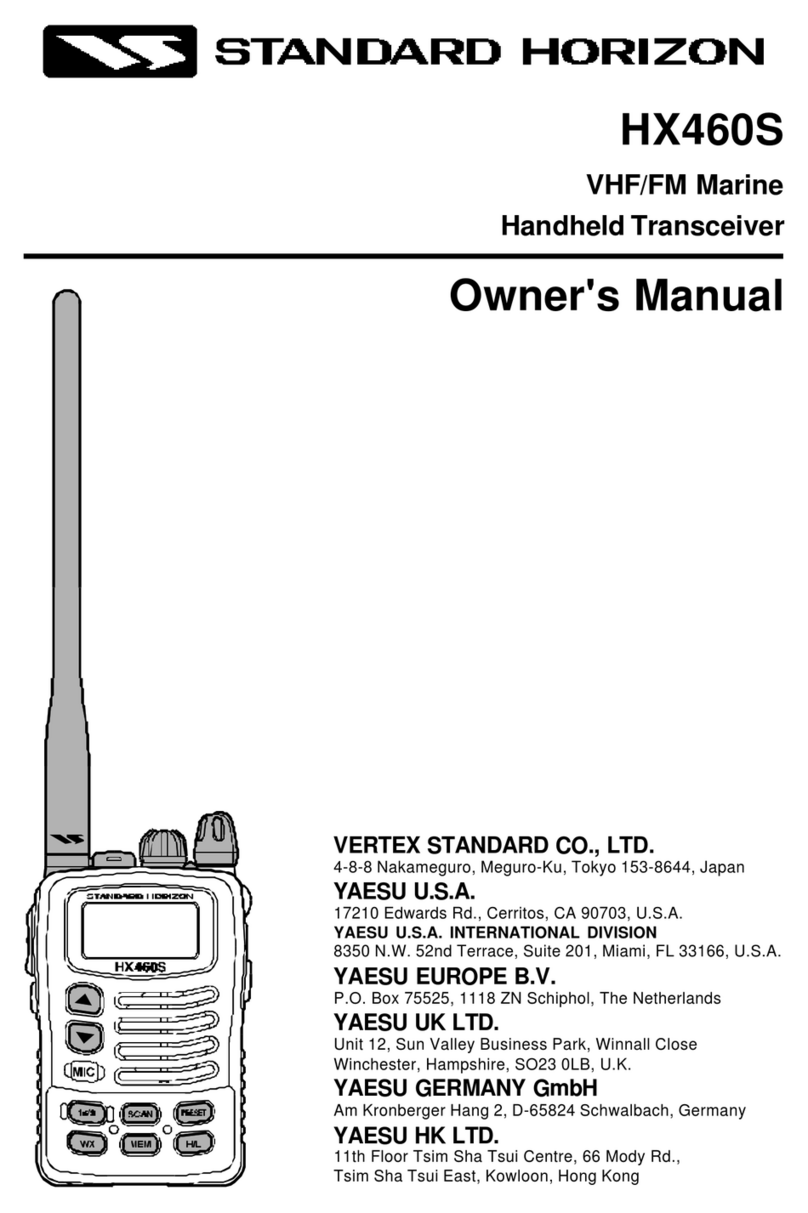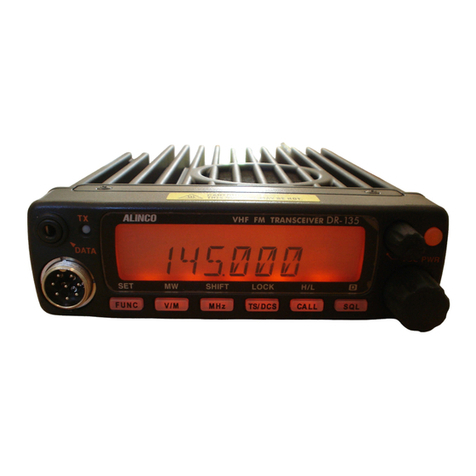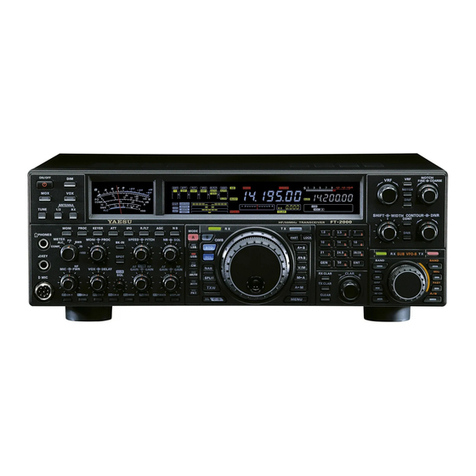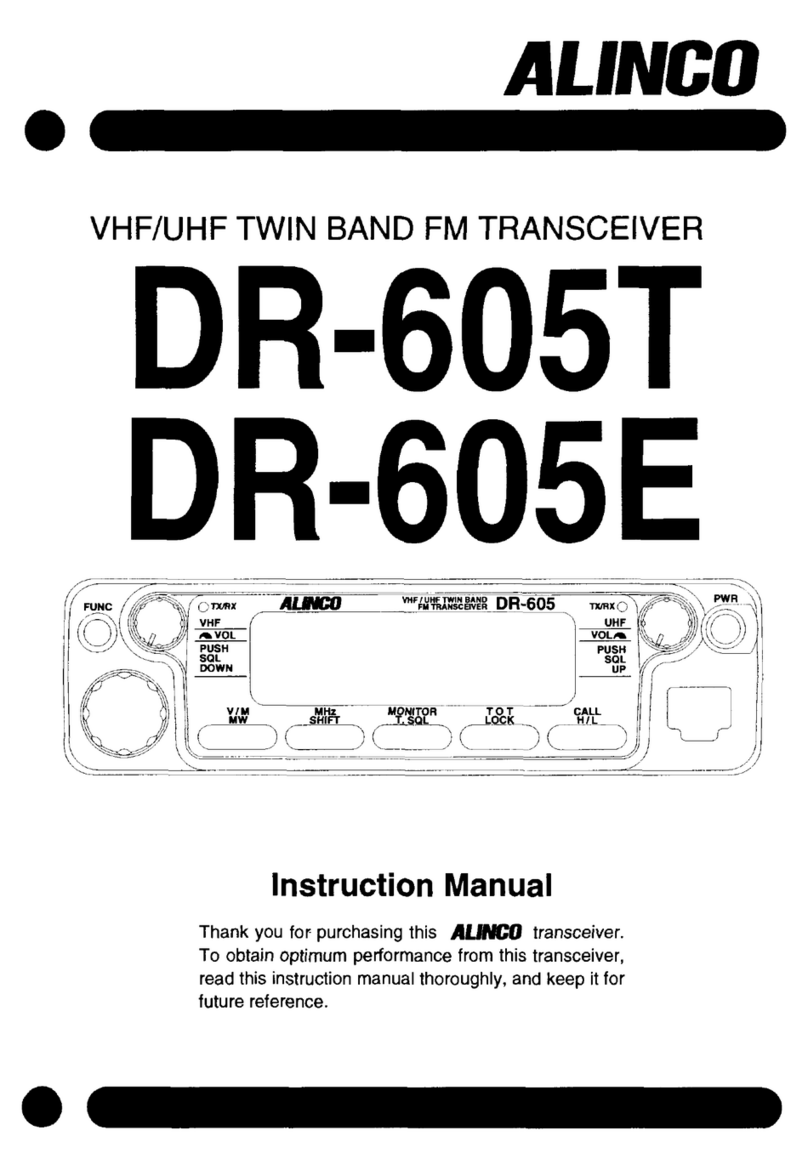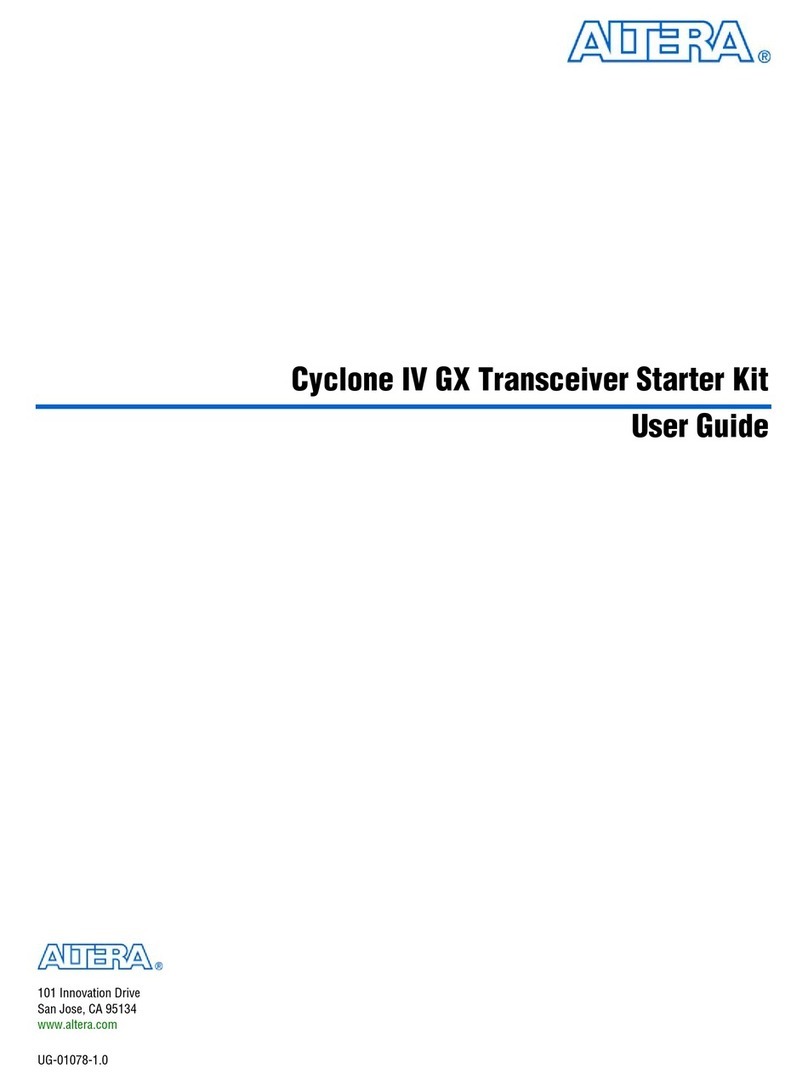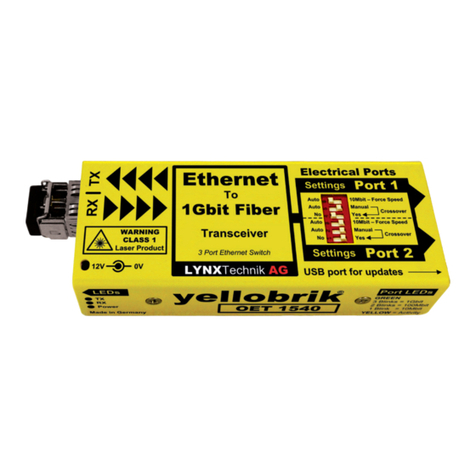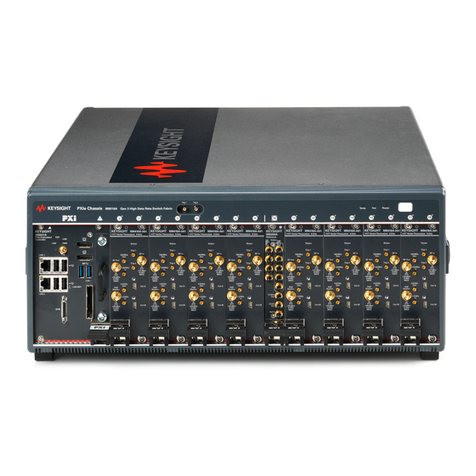Digital Wireless Corporation WIT2410 Quick setup guide

WIT2410
2.4GHz Spread Spectrum
Wireless Industrial Transceiver
Integration Guide
June 15, 1999
One Meca Wa
y
Norcross, Georgia 30093
www.digital-wireless.com
(770) 564-5540

Note: This device has not been authorized
as required by the rules of the Federal
Communications Commission. This device
is not, and may not be, offered for sale or
lease, or sold or leased, until authorization
is obtained.
About This Manual
This manual is designed to allow integration of the Digital Wireless Corporation WIT2410 OEM
module into complete products. Care has been taken to try and make sure all of the information
in this manual is accurate. However, specifications can change over time and Digital Wireless
cannot guarantee the accuracy of this information. If you have any questions on any information
in this manual, please contact Digital Wireless Technical Support at (770) 564-5540.

TABLE OF CONTENTS
1. INTRODUCTION..................................................................................................................................1
1.1 Why Spread Spectrum?.....................................................................................................................1
1.2 Frequency Hopping vs. Direct Sequence.........................................................................................2
2. RADIO OPERATION............................................................................................................................4
2.1. Synchronization and Registration...................................................................................................4
2.2. Data Transmission...........................................................................................................................5
2.2.1. Point-to-Point ........................................................................................................................5
2.2.2. Point-to-Multipoint................................................................................................................6
2.2.3. TDMA Mode.........................................................................................................................6
2.2.4. CSMA Mode .........................................................................................................................8
2.2.5. Full Duplex Communication.................................................................................................8
2.2.6. Error-free Packet Transmission Using ARQ.........................................................................8
2.3. Modes of Operation.........................................................................................................................9
2.3.1. Control and Data Modes........................................................................................................9
2.3.2. Sleep Mode..........................................................................................................................10
2.3.3. Low Power Mode and Duty Cycling...................................................................................10
3. PROTOCOL MODES..........................................................................................................................11
3.1. Packet Formats..............................................................................................................................12
3.1.1. Data Packet..........................................................................................................................13
3.1.3. Connect Packet....................................................................................................................13
3.1.4. Disconnect Packet (base only, receive only)......................................................................13
4. MODEM INTERFACE........................................................................................................................14
4.1. Interfacing to 5 Volt Systems........................................................................................................15
5. MODEM COMMANDS......................................................................................................................16
5.1. Serial Commands..........................................................................................................................16
5.2. Network Commands......................................................................................................................17
5.3. Protocol Commands......................................................................................................................19
5.4. Status Commands..........................................................................................................................21
5.5. Memory Commands......................................................................................................................22
5.6. Modem Command Summary........................................................................................................23
6. WIT2410 DEVELOPER’S KIT...........................................................................................................24
6.1. COM24..........................................................................................................................................24
6.2. Demonstration Procedure..............................................................................................................25
6.3. Troubleshooting ............................................................................................................................26
7. APPENDICES......................................................................................................................................28
7.1. Technical Specifications ...............................................................................................................28
7.1.1. Power Specifications...........................................................................................................28
7.1.2. RF Specifications.................................................................................................................28
7.2.2. Mechanical Specifications...................................................................................................28
7.3. Serial Connector Pinouts...............................................................................................................29
7.4. Approved Antennas.......................................................................................................................29
7.5. Technical Support .........................................................................................................................29
7.6. Mechanical Drawing.....................................................................................................................30
7.7. Warranty........................................................................................................................................31

© 1999 Digital Wireless Corporation 16/15/99
1. INTRODUCTION
The WIT2410 radio transceiver provides reliable wireless connectivity for either
point-to-point or multipoint applications. Frequency hopping spread spectrum technology
ensures maximum resistance to noise and multipath fading and robustness in the presence of
interfering signals, while operation in the 2.4 GHz ISM band allows license-free use and
worldwide compliance. A simple serial interface supports asynchronous data up to 230400
bps. An on-board 3 KB buffer and an error-correcting over-the-air protocol provide smooth
data flow and simplify the task of integration with existing applications.
-Multipath fading impervious
frequency hopping technology
with 75 frequency channels
(2401-2475 MHz).
- Supports point-to-point or
multipoint applications.
- Meets FCC rules 15.247 and ETS
300.328 for worldwide license-
free operation.
- Superior range to 802.11 wireless
LAN devices.
- Transparent ARQ protocol
w/3KB buffer ensures data
integrity.
- Digital addressing supports up to
32 networks, with 62 remotes per
network.
- Low power 3.3v CMOS signals
- Simple serial interface handles both
data and control at up to 230400
bps.
- Fast acquisition typically locks to
hopping pattern in 5 seconds or less.
- Selectable 10 mW or 100 mW
transmit power.
- Support for diversity antenna.
- Built-in data scrambling reduces
possibility of eavesdropping.
- Nonvolatile memory stores
configuration when powered off.
- Smart power management features
for low current consumption.
- Dynamic TDMA slot assignment
that maximizes throughput.
1.1 Why Spread Spectrum?
The radio transmission channel is very hostile, corrupted by noise, path loss and
interfering transmissions from other radios. Even in a pure interference-free
environment, radio performance faces serious degradation through a phenomenon
known as multipath fading. Multipath fading results when two or more reflected rays of
the transmitted signal arrive at the receiving antenna with opposing phase, thereby
partially or completely canceling the desired signal. This is a problem particularly
prevalent in indoor installations. In the frequency domain, a multipath fade can be
described as a frequency-selective notch that shifts in location and intensity over time as
reflections change due to motion of the radio or objects within its range. At any given
time, multipath fades will typically occupy 1% - 2% of the 2.4 GHz band. This means
that from a probabilistic viewpoint, a conventional radio system faces a 1% - 2% chance
of signal impairment at any given time due to multipath.

© 1999 Digital Wireless Corporation 26/15/99
Spread spectrum reduces the vulnerability of a radio system to both interference from
jammers and multipath fading by distributing the transmitted signal over a larger region
of the frequency band than would otherwise be necessary to send the information. This
allows the signal to be reconstructed even though part of it may be lost or corrupted in
transit.
Figure 1
Narrowband vs. spread spectrum in the presence of interference
1.2 Frequency Hopping vs. Direct Sequence
The two primary approaches to spread spectrum are direct sequence (DS) and frequency
hopping (FH), either of which can generally be adapted to a given application. Direct
sequence spread spectrum is produced by multiplying the transmitted data stream by a
much faster, noise-like repeating pattern. The ratio by which this modulating pattern
exceeds the bit rate of the baseband data is called the processing gain, and is equal to the
amount of rejection the system affords against narrowband interference from multipath
and jammers. Transmitting the data signal as usual, but varying the carrier frequency
rapidly according to a pseudo-random pattern over a broad range of channels produces a
frequency hopping spectrum system.

© 1999 Digital Wireless Corporation 36/15/99
Figure 2
Forms of spread spectrum
One disadvantage of direct sequence systems is that due to spectrum constraints and the
design difficulties of broadband receivers, they generally employ only a minimal amount
of spreading (typically no more than the minimum required by the regulating agencies).
For this reason, the ability of DS systems to overcome fading and in-band jammers is
relatively weak. By contrast, FH systems are capable of probing the entire band if
necessary to find a channel free of interference. Essentially, this means that a FH
system will degrade gracefully as the channel gets noisier while a DS system may
exhibit uneven coverage or work well until a certain point and then give out completely.
Because it offers greater immunity to interfering signals, FH is often the preferred
choice for co-located systems. Since direct sequence signals are very wide, they tend to
offer few non-overlapping channels, whereas multiple hoppers may interleave with less
interference. Frequency hopping does carry some disadvantage in that as the transmitter
cycles through the hopping pattern it is nearly certain to visit a few blocked channels
where no data can be sent. If these channels are the same from trip to trip, they can be
memorized and avoided; unfortunately, this is generally not the case, as it may take
several seconds to completely cover the hop sequence during which time the multipath
delay profile may have changed substantially. To ensure seamless operation throughout
these outages, a hopping radio must be capable of buffering its data until a clear channel
can be found. A second consideration of frequency hopping systems is that they require
an initial acquisition period during which the receiver must lock on to the moving carrier
of the transmitter before any data can be sent, which typically takes several seconds. In
summary, frequency hopping systems generally feature greater coverage and channel
utilization than comparable direct sequence systems. Of course, other implementation
factors such as size, cost, power consumption and ease of implementation must also be
considered before a final radio design choice can be made.
As an additional benefit, RF spectrum has been set aside at 2.4 GHz in most countries
(including the U.S.) for the purpose of allowing compliant spread spectrum systems to
operate freely without the requirement of a site license. This regulatory convenience
alone has been a large motivation for the industry-wide move toward spread spectrum.

© 1999 Digital Wireless Corporation 46/15/99
2. RADIO OPERATION
2.1. Synchronization and Registration
As discussed above, frequency hopping radios periodically change the frequency at which
they transmit. In order for the other radios in the network to receive the transmission, they
must be listening to the frequency over which the current transmission is being sent. To do
this, all the radios in the net must be synchronized and must be set to the same hopping
pattern. All radios in a net must be set to the same hopping pattern before attempting to
communicate.
In point-to-point or point-to-multipoint arrangements, one radio module is designated as the
base station. All other radios are designated remotes. One of the responsibilities of the base
station is to transmit a synchronization signal to the remotes to allow them to synchronize
with the base station. Since the remotes know the hopping pattern, once they are
synchronized with the base station, they know which frequency to hop to and when. Every
time the base station hops to a different frequency, it immediately transmits a synchronizing
signal.
When a remote is powered on, it rapidly scans the frequency band for the synchronizing
signal. Since the base station is transmitting over 75 frequencies and the remote is scanning
75 frequencies, it can take several seconds for a remote to synch up with the base station.
Once a remote has synchronized with the base station, it must request registration from the
base station. The registration process identifies to the base station the remotes from which
transmissions will be received and not discarded. Registration also allows tracking of
remotes entering and leaving the network. The base station builds a table of serial numbers
of registered remotes. To improve efficiency, the 24-bit remote serial number is assigned a
6-bit “handle” number. Two of these are reserved for system use, thus each base station can
register 62 separate remotes. This handle is how user applications will know the remotes. If
necessary, the automatic handle assignment can be overridden to explicitly tie certain handles
to certain remotes. See the section on Network Commands for details on the Set Default
Handle command.
To detect if a remote has gone offline or out of range, the registration must be “renewed”
once every 256 hops. Registration is completely automatic and requires no user application
intervention. When the remote is registered, it will receive several network parameters from
the base. This allows the base to automatically update these network parameters in the
remotes over the air. Once a parameter has been changed in the base, it is automatically
changed in the remotes. The parameters automatically changed are hop duration, the duty
cycle and the multiple access mode, i.e., TDMA or CSMA.
At the beginning of each hop, the base station transmits a synchronizing signal. After the
synchronizing signal has been sent, the base will transmit any data in its buffer unless packet
transmit delay has been set. The packet transmit delay parameter allows for the transmission
of groups of continuous data in transparent mode (protocol mode 0). In TDMA mode the

© 1999 Digital Wireless Corporation 56/15/99
amount of data that the base station can transmit per hop is determined by the hop duration
and the number of remotes registered with the base. In CSMA mode, the maximum amount
of data sent is determined by maximum data length. In any event, the maximum amount of
data sent by a base station or remote per hop is 127 bytes. If there is no data to be sent, the
base station will not transmit until the next frequency.
The operation of the remotes depends on whether the remote is set up for TDMA mode or
CSMA mode. In TDMA mode, the operation of the remotes is the same as the base station
without the synchronization signal.
In CSMA mode, remotes compete on an ad hoc basis for transmission time. The likelihood
that a remote with will attempt to transmit immediately is affected by the persistence
parameter. If a collision is detected with another radio, the remote will wait a random period
of time before trying to retransmit. The backoff parameter controls the maximum time a
remote will wait before attempting to retransmit. Unregistered remotes can request
registration any time after the base station transmission. Refer to the section Protocol
Commands for details on the persistence and backoff parameters.
Except for the registration process which occurs only when a remote logs onto the network,
the whole procedure is repeated on every frequency hop. Refer to the section on Modem
Commands for complete details on parameters affecting the transmission of data.
2.2. Data Transmission
The WIT2410 supports two network configurations: point-to-point and point-to-multipoint.
In a point-to-point network, one radio is set up as the base station and the other radio is set up
as a remote. In a point-to-multipoint network, a star topology is used with the radio set up as
a base station acting as the central communications point and all other radios in the network
set up as remotes. In this configuration, all communications take place between the base
station and any one of the remotes. Remotes cannot communicate directly with each other.
It should be noted that point-to-point mode is a subset of point-to-multipoint mode and
therefore there is no need to specify one mode or the other.
2.2.1. Point-to-Point
In point-to-point mode, unless packet transmit delay has been set, the base station will
transmit whatever data is in its buffer limited to 127 bytes or by the length of the base slot
size. If the base station has more data than can be sent on one hop, the remaining data will be
sent on subsequent hops. In addition to the data, the base station adds some information to
the transmission over the RF link. It adds the address of the remote to which it is
transmitting, even though in a point-to-point mode there is only one remote. It also adds a
sequence number to identify the transmission to the remote. This is needed in the case of
acknowledging successful packets and retransmitting errored packets. Also added is a 24-bit
CRC to allow the base to check the received transmission for errors. When the remote
receives the transmission, it will acknowledge the transmission if it was received without

© 1999 Digital Wireless Corporation 66/15/99
errors. If no acknowledgment is received, the base station will retransmit the same packet on
the next frequency hop.
In point-to-point mode, a remote will transmit whatever data is in its buffer up to the limit of
its maximum packet length. If desired, a minimum packet length can also be set, which forces
the remote to wait until a certain amount of data is available or the specified packet transmit
delay is exceeded before transmitting. If the remote has more data than can be sent on one
hop, it will send as much data as possible as a packet, adding its own address, a packet
sequence number and 24-bit CRC. These additional bytes are transparent to the user
application if the protocol mode is 00 (which is the default). In the event a remote has more
data to send, the data will be sent on subsequent hops. If the packet is received by the base
station without errors, the base station will acknowledge the packet. If the remote does not
receive an acknowledgment, it will retransmit the packet on the next frequency hop. To the
user application, acknowledgments and retransmissions all take place behind the scenes
without the need for user intervention.
2.2.2. Point-to-Multipoint
In point-to-multipoint mode, data sent from the user application to the base station must be
packetized by the user application. This is necessary to identify the remote to which the base
station should send data. When the user packet is received by the remote, if the remote is in
transparent mode (protocol mode 0), the packetization bytes are stripped by the remote. In
this instance the remote host receives just data. If the remote is not in transparent mode, the
remote host will receive the appropriate packet header as specified by the remote’s protocol
mode. Refer to the section Protocol Modes for details on the various packet formats.
When a remote sends data to a base station in point-to-multipoint mode, the remote host does
not need to perform any packetization of the data. The remote will add address, sequence
and CRC bytes as in the point-to-point mode. When the base station receives the data, the
base station will add packetization header bytes according to its protocol mode setting.
2.2.3. TDMA Mode
For applications needing guaranteed bandwidth availability, the TDMA mode of the
WIT2410 can meet this requirement. This is the default mode of the WIT2410. In TDMA
mode, each remote has an assigned time slot during which it can transmit. The base station
time slot is set independently of the remote time slots through the Set Base Slot Size
command. The base station assigns each remote a time slot and informs the remotes of the
size of the time slot. All remote time slots are the same size which is determined by the
number of remotes registered with the base station. The slot size is a dynamic variable that
changes as the number of registered remotes changes. The remotes are continually updated
with the time slot size. This approach continually maximizes the data throughput. The base
station divides the amount of time available per hop by the number of registered remotes up
to a maximum of 16 times slots per hop. If the number of registered remotes is greater than
16, the time slots will be spread across the required number of hops. For networks with more

© 1999 Digital Wireless Corporation 76/15/99
than 16 possible remotes, the Set Duty Cycle command must be used to specify a duty cycle -
- the number of hops over which the time slots must be spread. For 1 to 16 remotes, no duty
cycle is required; for 17 to 32 remotes a duty cycle of at least ½ is required; and for 33 to 62
remotes a duty cycle of ¼ or more is necessary. An added benefit of using the power save
mode to set a duty cycle is improved average current consumption efficiency. Refer to the
Status Commands section for details of this command.
When setting up a TDMA network, keep in mind that time slot length, maximum packet size
and hop duration are all interrelated. The hop duration parameter will determine the time
slot size and the maximum amount of data that can be transmitted per hop by the remotes.
There is a hard limit of the absolute maximum amount of data that can be sent on any given
hop of 212 bytes regardless of any parameters. The base station requires 1.7 ms overhead for
tuning, the synchronization signal and parameter updating, as well as a guard time of 500 us
between each remote slot. Thus the amount of time allocated per remote slot is roughly:
hop duration – base slot – 1.7ms - ( # of registered remotes-1)·500us
( # of registered remotes)
Take for example a network comprised of a base station and 10 remotes. A hop duration of
15 ms is chosen. We decide that the base station needs to be able to send up to 32 bytes each
hop (equivalent to a capacity for the base of ~ 21 kbps). Counting the 1.7 ms overhead for
the base packet and making use of the fact that our RF rate is 460.8 kbps, we determine that
the base slot requires approximately:
Each remote time slot will be:
15 ms – 2.3 ms – (9)·0.5 ms
10
From our RF data rate of 460.8kbps we see that it takes 17.36 µs to send a byte of data, so
each remote will be able to send up to
= 47 bytes of data per hop.
Note that the 47 bytes is the actual number of data bytes that can be sent. If the WIT2410 is
using a protocol mode, the packet overhead does not need to be considered. So in this
example, the total capacity per remote would be:
If we figure a minimum margin of safety for lost packets and retransmissions of about 20%,
we see that this would be more than sufficient to support 19.2 kbps of continuous data per
remote. It is also useful to remember that the asynchronous data input to the WIT2410 is
= 0.82 ms
0.82 ms
17.36
µ
s
32·8
460.8kbps+ 1.7 ms = 2.3 ms
47 bytes
15 ms = 25 kbps

© 1999 Digital Wireless Corporation 86/15/99
stripped of its start and stop bits during transmission by the radio, yielding a "bonus" of 10/8
or 25% in additional capacity.
The above calculations are provided as a means of estimating the capacity of a multipoint
WIT2410 network. To determine the precise amount of capacity, you can actually set up the
radio system and then query the maximum packet length from one of the remotes in control
mode to discover its exact setting. Divide this number by the hop duration as above to get
the remote's exact capacity.
2.2.4. CSMA Mode
CSMA mode is not currently available for the WIT2410.
2.2.5. Full Duplex Communication
From an application perspective, the WIT2410 communicates in full duplex. That is, both
the user application and the remote terminal can be transmitting data without waiting for the
other to finish. At the radio level, the base station and remotes do not actually transmit at the
same time. If they did, the transmissions would collide. As discussed earlier, the base
station transmits a synchronization signal at the beginning of each hop followed by up to
three packets of data. After the base station transmission, the remotes will transmit. Each
base station and remote transmission may be just part of a complete transmission from the
user application or the remote terminal. Thus, from an application perspective, the radios are
communicating in full duplex mode since the base station will receive data from a remote
before completing a transmission to the remote.
2.2.6. Error-free Packet Transmission Using ARQ
The radio medium is a hostile environment for data transmission. In a typical office or
factory environment, 1% - 2% of the 2.4 GHz frequency band may be unusable at any given
time at any given station due to noise, interference or multipath fading. For narrowband
radio systems (and also many spread spectrum radio systems which use direct sequence
spreading), this would imply a loss of contact on average of over 30 seconds per hour per
station. The WIT2410 overcomes this problem by hopping rapidly throughout the band in a
pseudo-random pattern. If a message fails to get through on a particular channel, the
WIT2410 simply tries again on the next channel. Even if two thirds of the band are
unusable, the WIT2410 can still communicate reliably.
Data input to the WIT2410 is broken up by the radio into packets. A 24-bit checksum is
attached to each packet to verify that it was correctly received. If the packet is received
correctly, the receiving station sends an acknowledgment, or ACK, back to the transmitting
station. If the transmitter doesn't receive an ACK, at the next frequency hop it will attempt to

© 1999 Digital Wireless Corporation 96/15/99
send the packet again. When ARQ is enabled, the transmitting radio will attempt to send a
packet packet attempts limit times before discarding the packet. A value of 00H disables
ARQ. When it is disabled, it is the responsibility of the user application to track errored or
missing packets. A second parameter, ARQ Mode, allows the choice between using ARQ to
resend errored packets or always sending a packet packet attempts limit times regardless of
the success or failure of any given transmission.
All of this error detection and correction is transparent to the user application. All the user
application sees is non-errored data from the modem. However, if the ARQ mode is
disabled, error detection and correction will be the responsibility of the user application.
Refer to the Protocol Commands section for complete details.
2.3. Modes of Operation
2.3.1. Control and Data Modes
The WIT2410 has two modes of operation: Control mode and Data mode. When in Control
Mode, the various radio and modem parameters can be modified. When in Data Mode, only
data can be transmitted. The default mode is Data Mode. There are two ways to enter
Control Mode. The first way is to assert the Configure (CFG) pin on the modem. Upon
entering Control Mode, the modem will respond with a >prompt. After each command is
entered, the modem will again respond with a >prompt. As long as the CFG pin is asserted,
data sent to the modem will be interpreted as command data. Once the CFG pin is
deasserted, the modem will return to Data Mode.
The second method for entering Control Mode is to send the escape sequence :wit2410 (all
lower case) followed by a carriage return. In the default mode, the escape sequence is only
valid immediately after power up or after deassertion of the Sleep pin on the modem. The
modem will respond in the same way with a >prompt. To return to Data Mode, enter the
Exit Modem Control Mode command, z>, or assert and deassert the Sleep pin. There are
three modes for the escape sequence, controlled by the Set Escape Sequence Mode comand,
zc:
zc=0 Escape sequence disabled
zc=1 Escape sequence available once at startup (default setting)
zc=2 Escape sequence available at any time
The zc2 mode setting is useful if the user application has a need to change the modem
settings "on the fly". In this mode the escape sequence is always and may be sent at any time
after a pause of at least 20ms. The modem will respond in the same way as when in the
default mode. It is necessary to issue the Exit Modem Control Mode command, z>, before
resuming data transmission. The escape sequence must be interpreted as data until the last
character is received and as such may be transmitted by the modem to any listening modems.

© 1999 Digital Wireless Corporation 10 6/15/99
2.3.2. Sleep Mode
To save power consumption for intermittent transmit applications, the WIT2410 supports a
Sleep Mode. Sleep Mode is entered by asserting the Sleep pin on the modem interface.
While in Sleep Mode, the modem consumes less than 50µA. This mode allows the radio to
be powered off while the terminal device remains powered. After leaving Sleep Mode, the
radio must re-synchronize with the base station and re-register.
2.3.3. Low Power Mode and Duty Cycling
To conserve power, WIT2410 remotes power down the receiver and transmitter between
hops when not in use. Base stations must remain active all the time to handle any
transmission from any remote. Remotes can save even more power by enabling the duty
cycle feature. This feature causes a remote to power down for 2Nfrequency hops where 1/2N
is the duty cycle. Rather than attempting to transmit on every frequency hop when data is in
the transmit buffer, a remote will attempt to transmit only every 2Nhops. Roughly speaking,
this will proportionately reduce the average power consumption while increasing average
latency. When there are more than 16 remotes being operated in TDMA mode, duty cycling
must be enabled since a maximum of 16 time slots are available per hop.

© 1999 Digital Wireless Corporation 11 6/15/99
3. PROTOCOL MODES
In point-to-point applications, it is generally desired that the radios operate in a transparent
mode. That is, raw unformatted data is sent from the host to the radio and is received as raw
data from the receiving end. The addressing and error detection and correction is still
performed by the radios, but it is transparent to the user application. To set up a point-to-
point network, one radio has to be set up as a base station. When the radios are powered on,
the base station will send out the synchronization signal at the beginning of each hop. The
remote will synchronize with the base and automatically request registration. Once the
remote is registered, the radios can transmit data. Protocol mode operation is available in
point-to-point mode if desired.
In point-to-multipoint mode, the data sent to the base station by the user application must
adhere to a packet format. This allows transmissions from the base station to be directed to a
specific remote. Data received by a base station from a remote is similarly formatted to
identify to the user application the remote that sent the transmission. The remotes may still
use transparent mode without formatting to send data to the base, if desired. The WIT2410
supports 12 protocol formats which are described in detail below. The protocol format is
selected through the Set Protocol Mode command.
mode 00 Transparent mode used for point-to-point networks or
multipoint remotes; does not support any packet types.
mode 01 This is the simplest protocol mode supporting Data and
Command packets only. No CONNECT or
DISCONNECT packets are supported and no sequence
numbers are provided.
packet types supported: Data
mode 02 This mode includes notification when remotes are
registered or dropped through CONNECT and
DISCONNECT packets that are sent to the user
application at the base station and at the remote. No
sequence numbers are provided.
packet types supported: Data
CONNECT
DISCONNECT
mode 04 This is the packet format used by the WIT2400. This
allows legacy software to operate the WIT2410. Note
however, that since different air data rates are used,
WIT2410s and WIT2400s cannot be mixed in a
network.
packet types supported: 2400 data format
(addresses must be limited to 0..62)

© 1999 Digital Wireless Corporation 12 6/15/99
modes 05 – 08 reserved for future use.
mode 09 This mode sends the protocol mode 01 packets during
transmit but receives data transparently.
mode 0A This mode sends the protocol mode 02 packets during
transmit but receives data transparently.
mode 0C This mode sends the protocol mode 04 packet during
transmit but receives data transparently.
modes 0D – 0F reserved for future use.
mode 11 This mode sends data transparently but supports
protocol mode 1 during reception.
mode 12 This mode sends data transparently but supports
protocol mode 2 during reception.
mode 14 This mode sends data transparently but supports
protocol mode 4 during reception.
3.1. Packet Formats
The byte formats for each packet type are shown in the table below. Packet fields are
organized to fall on byte boundaries. In the case of bit-level fields, most-significant bits are
on the left.
WIT2400 packet type (mode 04):
DATA 0000 0010 00HH HHHH 0LLL LLLL <0-127 bytes data> 0000 0011
MRTP (WIT2410) packet types (modes 01-03):
Transmit and Receive:
DATA 1110 1001 00HH HHHH 0LLL LLLL <0-127 bytes data>
Receive only:
CONNECT 1110 1001 10HH HHHH RRRR TTTT 00NN NNNN <3 byte remote ID>
DISCONNECT 1110 1001 11HH HHHH 0111 1111
H: handle number (0-63)
L: data length (0-127)
N: remote's previous network number (if roamed)
R: receive sequence number (from previous cell)
T: transmit sequence number (from previous cell)

© 1999 Digital Wireless Corporation 13 6/15/99
3.1.1. Data Packet
Modes 01 & 02: 1110 1001 00HH HHHH 0LLL LLLL <0-127 bytes data>
Mode 04 (WIT2400): 0000 0010 00HH HHHH 0LLL LLLL <0-127 bytes data> 0000 0011
H: handle number (0-63)
L: data length (0-127)
This packet carries user data. The handle number is the handle of the sending or receiving
remote, depending on whether the data is going to or coming from the base. Up to 127 bytes
of user data may be carried per data packet.
Handle 63 is reserved for broadcast packets from the base to all remotes. Acknowledgment
requests are not supported for broadcasts. For this reason, it is a good idea to send broadcast
messages several times to increase the odds of reaching all remotes.
3.1.3. Connect Packet
1110 1001 10HH HHHH RRRR TTTT 00NN NNNN <3-byte remote ID> (base, receive only)
H: handle number (0-62)
R: receive sequence number (from previous cell)
T: transmit sequence number (from previous cell)
N: network number of the previous base (if roamed)
1110 1001 10HH HHHH RRRR TTTT 00NN NNNN <3-byte base ID> (remote, receive only)
H: handle number (0-62)
R: receive sequence number
T: transmit sequence number
N: network number of base
Remotes must go through an automatic registration process when roaming from one base to
another, after loss of contact, or when acquiring a base signal for the first time after power
up. The base then assigns the remote a handle value, may or may not assign it a dedicated
time slice depending on the user settings, and notifies the user application of the new remote
with a connect packet.
The network number of the last base the remote was connected to is given to aid user
software in resending orphan packets that may have been sent to the remote's previous cell.
If the remote has been powered up for the first time and this is the first base contacted, the
last base ID will be reported as FFH.
3.1.4. Disconnect Packet (base only, receive only)
1110 1001 10HH HHHH 0111 1111
H: handle number (1-62)
When a remote goes out of range or roams to another cell, the base issues a disconnect packet
to indicate that the remote is no longer available.

© 1999 Digital Wireless Corporation 14 6/15/99
4. MODEM INTERFACE
Electrical connection to the WIT2410 is made through a 16-pin male header on the modem
module. The signals are 3.3 volt signals and form an RS-232 style asynchronous serial
interface. The table below provides the connector pinout.
Pin Signal Type Description
1 GND - Signal and chassis ground
2 TXD Input Transmit data. Input for serial data to be transmitted. In Control
Mode also used to transmit modem commands to the modem.
3 RXD Output Receive data. Output for received serial data. In Control Mode, also
carries receive modem status from the modem.
4 Input Configuration selector. Used to switch between Control and Data
Modes. Normally, CFG will be set for Data Mode. An internal 10K
pull-up enables Data Mode if this signal is left unconnected. Control
Mode is also accessible by transmitting an escape sequence
immediately after wake up or power up.
(0v) 1 = Control Mode
(3.3v) 0 = Data Mode
5 Input Request to send. Gates the flow of receive data from the radio to
the user on or off. In normal operation this signal should be
asserted. When negated, the WIT2410 buffers receive data until
RTS is asserted.
(0v) 1 = Receive data (RxD) enabled
(3.3v) 0 = Receive data (RxD) disabled.
6SLEEP Input Sleeps/wakes radio transceiver. In sleep mode all radio functions
are disabled consuming less than 50µA. At wake up, any user
programmed configuration settings are refreshed from non-volatile
memory, clearing any temporary settings that may have been set.
(3.3v) 1 = Sleep Radio
(0v) 0 = Wake Radio
7 Output Data carrier detect. For remotes, indicates the remote has
successfully acquired the hopping pattern of the base station.
(0v) 1 = Carrier detected (synchronized)
(3.3v) 0 = No carrier detected (not synchronized)
8 Output Clear to send. Used to control transmit flow from the user to the
radio. (0v) 1 = Transmit buffer not full, continue transmitting
(3.3v) 0 = Transmit buffer full, stop transmitting
9-15 - - Reserved for future use. Do not connect.
16 VCC - Positive supply. Min 3.3 v, 5.0 v nominal, 10.0 v max.
RTS
DCD
CTS
CFG

© 1999 Digital Wireless Corporation 15 6/15/99
4.1. Interfacing to 5 Volt Systems
The modem interface signals on the WIT2410 are 3.3 volt signals. To interface to 5 volt
signals, the resistor divider network shown below must be placed between the 5 volt signal
outputs and the WIT2410 signal inputs. The output voltage swing of the WIT2410 3.3 volt
signals is sufficient to drive 5 volt logic inputs.
10 kΩ
15 kΩ
From 5v
Output To 3.3v Input

© 1999 Digital Wireless Corporation 16 6/15/99
5. MODEM COMMANDS
The WIT2410 is configured and controlled through a series of commands. These commands
are sent to the modem directly when the modem is in Control Mode or through Command
Packets when the modem is in Data Mode. The command syntax is the same for either
method, a one- or two-letter command followed by one or more parameters. The modem
will respond with a two-byte message that indicates the new modem parameter value. The
commands are loosely grouped into five different categories: Serial commands, Network
commands, Protocol commands, Status commands and Memory commands. Each command
is described in detail below. In the descriptions, brackets ([,]) are used to denote a set of
optional arguments. Vertical slashes (|) separate selections. For example, given the string
wn[?|0..3f], some legal commands are wn?, wn0, wn3 and wna. Most commands which set
a parameter also have a ?option which causes the modem to respond with the current
parameter setting, e.g., wn?
5.1. Serial Commands
These commands affect the serial interface between the modem and the host. The default
settings are 9600 bps and protocol mode 0.
Command Description
sd[?|00..FF] Set Data Rate Divisor
Data Rate Divisor (hex)
1200 bps = BF
2400 bps = 5F
9600 bps = 17
14400 bps = 0F
19200 bps = 0B
28800 bps = 07
38400 bps = 05
57600 bps = 03
115200 bps = 01
230400 bps =00
sp[?|00..14] Set Protocol Mode
00 = point-to-point transparent mode
01 = basic command and data only
02 = command, data and connection notification
04 =
WIT2400 protocol mode
05 – 08 =reserved for future use
09 = mode 01 during transmit, transparent receive
0A = mode 02 during transmit, transparent receive
0C = mode 04 during transmit, transparent receive
0D – 10 =reserved for future use
11 = transparent transmit, mode 01 during receive
12 = transparent transmit, mode 02 during receive
14 = transparent transmit, mode 04 during receive

© 1999 Digital Wireless Corporation 17 6/15/99
Set Data Rate Divisor
Sets the serial bit rate between the modem and the host. This command takes effect
immediately and will require adjusting the host serial rate to agree. Nonstandard rates may
be programmed by entering a data rate divisor computed with the following formula:
DIVISOR = (230400/RATE)-1
Round all non-integer values down.
Set Protocol Mode
Enables the base station to operate in a multipoint network. Depending on the user
application, more or less acknowledgment may be desired by the application. Remotes can
operate in transparent mode even though the base station is operating in one of the
nontransparent modes.
When using a protocol mode, make sure to count in packet overhead when calculating
network performance. Refer to the section on Protocol Modes for details on each format.
5.2. Network Commands
Network commands are used to set up a WIT2410 network and to set radio addressing and
configuration.
Command Description
wb[?|0|1] Set Transceiver Mode
0= remote (default)
1= base station
wd[?|0-3f] Set Default Handle
Used to override automatic handle assignment by the base station
30 = default
wg[?|0|1] Enable Global Network Mode
0= Link only to hop pattern specified by wn parameter (default)
1=Link to any hop pattern, regardless of wn parameter
wn[?|0-1f] Set Hopping Pattern (Network Number)
0= default
wp[?|0|1] Set Transmit Power
0 = 10mW
1 = 100mW (default)
wr? Read Receive Signal Strength
Set Transceiver Mode
Sets modem operation as either base station or remote. Default is remote.
Set Default Handle
Sets handle number between 1 and 62 inclusive for a remote. This handle will override the
automatic handle assignment by the base station. This command can be used in applications
where it is desired to have specific modems have specific handles.
Table of contents
Other Digital Wireless Corporation Transceiver manuals
